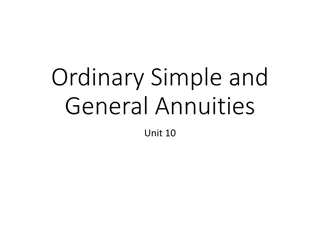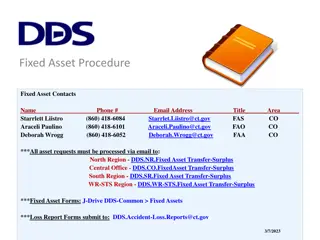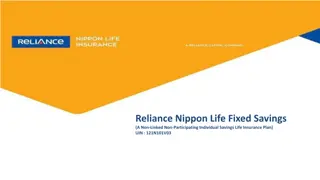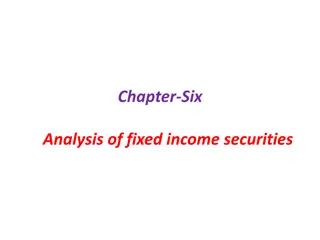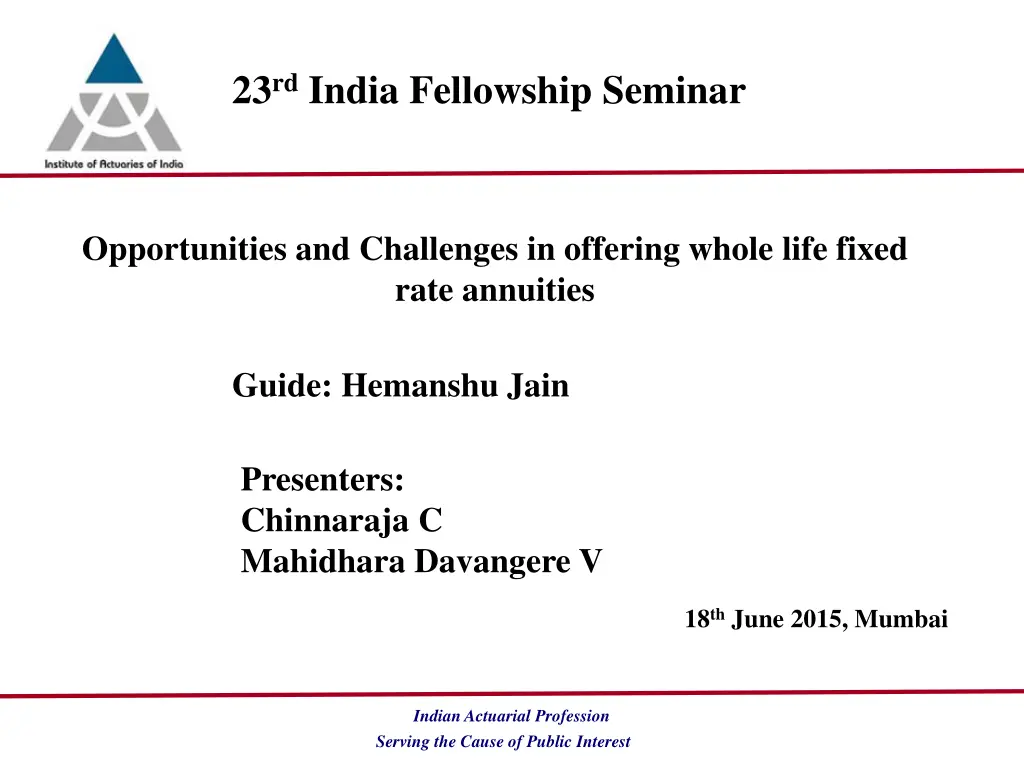
Indian Actuarial Seminar on Whole Life Annuities Challenges
Explore the opportunities and challenges of offering whole life fixed-rate annuities at the 23rd India Fellowship Seminar. Learn about different types of annuities, methodological analysis, and demographic transitions impacting the Indian market. Discover how India's growing demographic shift presents unique opportunities for pension schemes and life expectancy planning.
Uploaded on | 1 Views
Download Presentation

Please find below an Image/Link to download the presentation.
The content on the website is provided AS IS for your information and personal use only. It may not be sold, licensed, or shared on other websites without obtaining consent from the author. If you encounter any issues during the download, it is possible that the publisher has removed the file from their server.
You are allowed to download the files provided on this website for personal or commercial use, subject to the condition that they are used lawfully. All files are the property of their respective owners.
The content on the website is provided AS IS for your information and personal use only. It may not be sold, licensed, or shared on other websites without obtaining consent from the author.
E N D
Presentation Transcript
23rd India Fellowship Seminar Opportunities and Challenges in offering whole life fixed rate annuities Guide: Hemanshu Jain Presenters: Chinnaraja C Mahidhara Davangere V 18th June 2015, Mumbai Indian Actuarial Profession Serving the Cause of Public Interest
Agenda Annuities Types of Annuities Methodology Opportunities Challenges Conclusion www.actuariesindia.org 2
Annuities Series of future payments to a buyer (annuitant) in exchange for the immediate payment of a lump sum or a series of regular payments prior to the onset of the annuity Unknown duration based principally upon the date of death of the annuitant Longevity risk transferred to provider of annuity www.actuariesindia.org 3
Types of Annuities www.actuariesindia.org 4
Methodology Opportunities and Challenges analyzed under the following context: India growing steadily towards more developed nation India to experience same kind of demographic pattern as being experienced by more developed nation Projection of demographic numbers are sourced from United Nation External and environmental factors considered to access the demand for annuities www.actuariesindia.org 5
Opportunities Demographic Transition Demograph ic Transition Demographic Transition Demographic Transition Youngest Population Youngest Population Others Others Youngest Population Fertility Rate Fertility Rate Regulation Regulation Fertility Rate Opportunities Pension Scheme Pension Scheme Life Expectancy Life Pension Scheme Life Expectancy Expectancy Percapita Health Expense Percapita Health Expense Dependency Dependenc y Percapita Health Expense Dependency Percapita Health Expense www.actuariesindia.org 6
Demographic Transition (I) Full mid-section with predominance of young and middle age and significant volume at the older age Structure is in rather rapid transition to a more aged population with more than 30 per cent of older persons by 2050 India ranks 105 with 8.2% of world population aged 60+ in 2013 with 104m which is going to increase to 297m in 2050 India More Developed www.actuariesindia.org 7
Demographic Transition(II) India has 10 million population aged 80+ in 2013 which is going to increase to 37 million in 2050 becoming the second largest population in this category The number of centenarians in the world is projected to increase rapidly approximately 441,000 in 2013 to 3.4 million in 2050 and 20.1 million in 2100 from www.actuariesindia.org 8
Youngest population India has the world s highest number of 10 to 24-year-olds, with 356 million despite having a smaller population than China, which has 269 million young people India has nearly 4 times lower index level compared to developed nation Rapid expected increase in wealth and potential for huge market for pension solutions with both an accumulation phase and eventual income phase 250 Ageing Index 200 Developed India 150 100 50 0 1950 1975 2000 2025 2050 www.actuariesindia.org 9
Fertility rate Fertility rate of India to decrease further from current level of 3 as experienced by developed nation This further going add to the increased financial security required for old age 8 FERTILITY RATE (PER WOMAN) Developed India 6 4 2 0 1950-1955 1975-1980 2000-2005 2025-2030 2045-2050 www.actuariesindia.org 10
Life expectancy India Current expectancy of India is low India to reach a level as observed in 1980-85 of more developed nation in 2045-50 Developed nation to have higher life expectancy hence more scope in India for improvement 1980- 1985 2010- 2015 2030- 2035 2045- 2050 level of life Age 0 56.30 66.30 70.40 72.90 60 14.90 17.00 17.90 18.90 65 12.10 13.70 14.50 15.30 80 6.20 6.90 7.20 7.50 More Developed 1980- 1985 2010- 2015 2030- 2035 2045- 2050 Age 0 72.80 77.70 80.80 82.80 60 19.20 22.60 24.60 25.80 65 15.60 18.80 20.50 21.70 80 7.10 8.90 10.10 10.90 www.actuariesindia.org 11
Dependency India Dependency increase as the country develops Leading to more nuclear family structure indicating requirement for support at older age Old age dependency ratio of India to reach a level of developed nation observed after 2050 ratio to Depende ncy Ratio 1980 2013 2030 2050 Child 68.80 44.30 35.00 28.80 Old-age 6.40 8.00 12.00 18.70 Total 75.20 52.40 46.90 47.60 More Developed Depende ncy Ratio 1980 2013 2030 2050 Child 34.20 24.60 26.30 27.70 Old-age 17.80 25.30 36.60 44.40 Total 52.00 49.90 62.80 72.10 Region Female Male India More Developed 15.8 17.3 73.4 75.1 www.actuariesindia.org 12 2013,Proportion living independently, age 60+ (%)
Percapita health expense Per capita health expenditure tends to increase with population ageing and dependency ratio Currently India spends around $100 per capita on health compared to $3120 by Japan and $4833 by Western European countries Expected expense increase as India emerge as a developed nation Thus there is clear indication of increased in demand for financial certainty in older with old-age going to www.actuariesindia.org 13
Pension scheme National Pension Scheme (NPS) NPS introduced for Central Government employee in 2004 From 1st May, 2009 NPs available for all citizen on voluntary basis NPS accretes contribution of subscribers (18-60) years while working and uses the accumulation at retirement to procure a pension Atal Pension Yojna Focuses on unorganised sector, who do not have any formal pension provision APY is a Government scheme administered by PFRDA through NPS architecture launched in 2015 Subscriber joining at 18 years of age have to contribute Rs. 42 and Rs. 210 on monthly basis to get a fixed monthly pension of Rs 1000 and Rs 5000 respectively. Government co-contribution is 50% of the total contribution amount or Rs. 1000 per annum, whichever is lower, for a period of 5 years. Government co-contribution is available for those who are not covered by any Statutory Social Security Schemes and are not income tax payers. Guaranteed minimum monthly pension between Rs. 1000 and Rs. 5000 to the subscriber and spouse with return of corpus to the nominees after 60 years of age www.actuariesindia.org 14
Regulation Annuity purchase mandate post accumulation phase Under NPS before age of 60 subscriber need to invest 80% of the pension wealth to purchase life annuity from ASP and remaining 20% may be withdrawn as lump sum On attaining age of 60 need to invest 60% in life annuity ASP are annuity service provider empanelled with PFRDA FDI Increase the cap on foreign direct investment (FDI) in the insurance sector from 26 to 49 per cent Experience of developed nation insurer can be shared with local for development of annuity market Increased investment paving ways for new annuity products Local regulation aligning with the global solvency standards www.actuariesindia.org 15
Other Factors Diversification Allows life insurer to diversify the business risk Longevity risk act as a natural hedge against mortality risk Sales Channel NPS scheme using India Post to reach rural network Social media Telcassurance www.actuariesindia.org 16
Challenges Risks Risks Other Factors Other Factors Other Factors ALM ALM Challenges Alternative Investment Alternative Investment Regulation Regulation Alternative Investment www.actuariesindia.org 17
Risks Longevity risk Medical advance had resulted in increase in life expectancy Difficult to predict life expectancy based on past experience Information asymmetry with individual in good health taking the policy Market risk Annuity rate depends on the market condition at the time of buying resulting in lower amount of benefit during bearish phase Inflation may erode the real benefit of regular income from annuity www.actuariesindia.org 18
Risks Liquidity Most of the investment in pension scheme is not accessible until retirement Even on retirement only part of the accumulated amount can be opted as cash lump sum Alternative investment has more control and flexibility Operational risk Model and parameter risk in predicting the long term interest rate, life expectancy and expenses related to the scheme Higher chance of mismanagement of fund over the longer period of the policy Reputational risk if the obligation are not fulfilled or under paid affecting the social welfare of the country www.actuariesindia.org 19
ALM Longest tenor of government bonds available is 30 years Inflation index bonds with maximum tenor of 10 years Resulting in high rollover risk Longevity swap market not mature Longevity index used may not be exact replica of underlying population resulting in basis risk www.actuariesindia.org 20
Alternative investment Increased individual access to financial market due to internet and mobile banking Improving understanding of investment market Lower yield in Annuity products Individual making own provision by investing in bonds, equity and properties Equity release scheme where in no lump sum need to be made and individual can enter after retirement , but scheme provider may hedge their risk by buying annuity Self Managed Trust www.actuariesindia.org 21
Regulation Life insurer authorized to provide annuities, restricting the number of players Indian Assured Lives Mortality (2006-08) table used from April, 2013 to compute annuity which may not be appropriate for the target population Longevity and mortality risk are not allowed to offset for capital computation in current stator regime Insurers in India allowed to hedge interest rate risk with the benefit limited to 12 months under the rule of forecasted transactions Contribution towards pension scheme covered under 80C which also includes investment in ELSS, life insurance premium, home loan principal repayment, ULIPS, fixed deposits Income from annuity treated as income and fully taxable Service tax applicable on the initial annuity investment, currently 3.5% Discount and loading should not exceed 30% of the approved premiums Approval required to change the annuity rate by more than 10% increasing the Asset liability mismatch during large change in interest rate www.actuariesindia.org 22
Other Factors Traditional investment of relying on property as a financial security in old age Aligning the interest of insurance company and policy holders as unlike the life insurance policy both would not like the event of being paid which is not the case in annuity Agents preferred sales channel currently Present incentive structure for agents is often skewed in favour of non-annuity insurance products Commission in annuity up to 7.5% against 25% in life product in first year www.actuariesindia.org 23
Conclusion Huge opportunity and need in India for Whole Life Fixed Rate Annuities Tax Authorities, Regulators and the Insurance Industry need to come together to develop conducive environment Tax incentives for pension to drive the savings behaviour Regulatory changes to allow insurance companies hedge the financial guarantees Rapid population aging and rising life expectancies will lead to potentially huge demand for conventional annuity and annuity-like products NPS Scheme is expelled to increase demand for annuities www.actuariesindia.org 24




